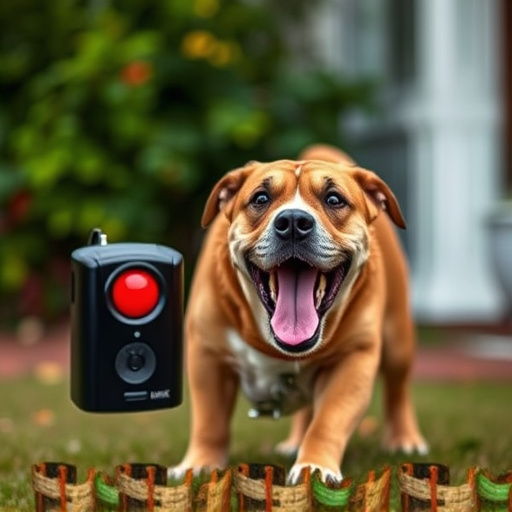Understanding and addressing aggressive pet behavior requires targeted deterrent strategies, with adjustable sound-level systems offering a versatile solution. This approach allows gradual desensitization over time, providing a non-confrontational alternative to harsh training methods. Modern pet deterrents with adjustable sound levels cater to diverse pet needs, ensuring efficacy and humane treatment. Implement these strategies by setting realistic expectations, training pets to associate sounds with behavior, regularly adjusting sound levels, and prioritizing animal welfare.
Introducing our comprehensive guide to innovative pet deterrents with adjustable sound levels, designed specifically for addressing aggressive animal behavior. This article delves into understanding the triggers behind such actions, offering insights on safety and efficacy considerations regarding sound-based deterrents. We explore how customizable sound modes can revolutionize training methods, catering to various pets’ unique needs. Furthermore, practical tips for implementation and maintenance ensure successful long-term results, transforming your living space into a harmonious environment for both you and your pets. Discover the game-changing potential of these dog repellent modes for aggressive pets.
- Understanding Aggressive Pet Behavior: Identifying Triggers and Solutions
- The Role of Sound in Pet Deterrents: Safety and Efficacy Considerations
- Adjustable Sound Levels: Customizing the Approach for Different Pets
- Implementing Effective Strategies: Tips for Training and Maintenance
Understanding Aggressive Pet Behavior: Identifying Triggers and Solutions
Understanding aggressive pet behavior is crucial for finding effective solutions, especially when dealing with dog repellent modes designed for such pets. Aggression in dogs can stem from various triggers—from territorial instincts to fear or pain. Identifying these triggers is key to implementing the right deterrent strategies. For instance, a dog may display aggression when strangers enter their space, certain sounds are made, or they encounter unfamiliar animals.
Dog repellent systems with adjustable sound levels offer a versatile solution. By controlling the intensity of noise, owners can gradually expose their pets to different environments and triggers, helping them desensitize over time. This approach is particularly useful for addressing aggressive reactions to specific sounds, like doorbells or children’s laughter. Additionally, it provides a non-confrontational way to manage pet behavior without resorting to harsh training methods.
The Role of Sound in Pet Deterrents: Safety and Efficacy Considerations
The role of sound in pet deterrents is a critical aspect often overlooked, yet it plays a pivotal part in their effectiveness and user safety. Traditional pet deterrent methods have relied heavily on visual cues or physical barriers to keep animals at bay. However, introducing adjustable sound levels as a dog repellent mode offers a unique advantage, especially for addressing aggressive pet behaviors. This innovative approach allows users to customize the intensity of the sound, ensuring it’s not just effective but also humane.
Safety and efficacy go hand in hand when considering pet deterrents. High-pitched sounds or intense noises can startle animals, but they should never cause physical harm. The ability to adjust sound levels means that users can employ a more nuanced approach, targeting specific aggressive behaviors without subjecting pets to excessive stress or discomfort. This feature is particularly beneficial for those seeking Dog Repellent Modes forAggressive Pets, as it offers a non-violent solution that respects both animal welfare and user preferences.
Adjustable Sound Levels: Customizing the Approach for Different Pets
Many pet deterrents on the market offer adjustable sound levels, a feature that allows users to customize their approach based on the type of pet they have. This is especially beneficial for dog owners dealing with aggressive pets. By adjusting the sound intensity, users can select a mode suitable for their dogs’ sensitivities without causing discomfort or distress.
For instance, a lower sound level might be effective in deterring smaller animals like cats or rabbits, while a higher setting could be necessary for larger, more stubborn dogs. This versatility ensures that the deterrent is not only effective but also humane, catering to various pet needs and behaviors.
Implementing Effective Strategies: Tips for Training and Maintenance
Implementing effective pet deterrent strategies involves a combination of training and maintenance. When introducing an adjustable sound device designed to deter aggressive pets, start by setting realistic expectations. Not all dogs respond in the same manner, so it’s crucial to understand that consistency and positive reinforcement are key. Train your pet to associate specific sounds with desired behaviors; for example, using a low-volume tone as a warning signal and high-intensity sounds as a last resort when the dog shows aggression or unwanted behavior.
Regular maintenance includes testing the device periodically to ensure it functions properly and adjusting sound levels as needed. Keep in mind that aggressive pets may require higher settings initially, but as they learn and adapt, you can gradually decrease the volume. Always follow manufacturer guidelines and consult with a professional trainer if your pet continues to exhibit problematic behaviors despite consistent training and adjustments. Additionally, ensure the device is used responsibly and ethically, respecting animal welfare and providing humane alternatives when possible.
Pet deterrents with adjustable sound levels offer a safe, effective solution for managing aggressive pet behavior. By understanding the role of sound in these devices and customizing the approach based on individual pets, owners can find a balanced approach to deterring unwanted behaviors without causing harm. Implementing effective training strategies and regular maintenance ensures that dog repellent modes remain successful over time, fostering a safer and more harmonious living environment for both pets and their owners.
